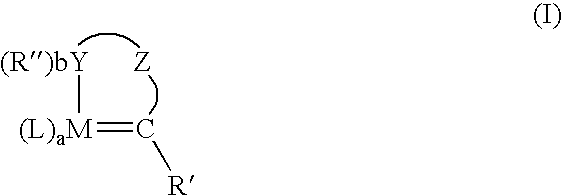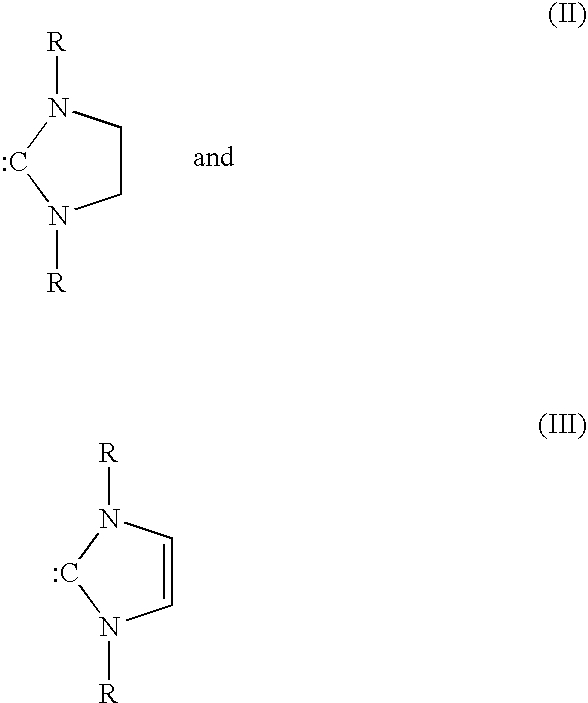Metathesis of unsaturated fatty acid esters or unsaturated fatty acids with lower olefins
- Summary
- Abstract
- Description
- Claims
- Application Information
AI Technical Summary
Benefits of technology
Problems solved by technology
Method used
Image
Examples
example 2
A polystyrene-supported chelated ruthenium complex was prepared as follows. First, a cross-linked polystyrene was functionalized. A solution of 2,3-dihydrobenzofuran (1.44 g, 11.9 mmol) in approximately 30 mL of degassed, anhydrous dimethylsulfoxide was added via cannula to sodium amide (0.466 g, 11.9 mmol) at room temperature. The resulting pale yellow solution was stirred at room temperature for 4 hours. Then, the solution was added via cannula to a cross-linked polystyrene resin (Merrifield resin, 3.0 g, 1.95 mmol Cl / g, 1% crosslinked) swollen with 50 ml of degassed, anhydrous tetrahydrofuran. The resulting mixture was stirred overnight at room temperature. The mixture was then heated at 55° C. for 3 hours. Afterwards, the mixture was cooled to room temperature, and methanol (100 mL) was added. A polymer product was isolated by filtration, washed with tetrahydrofuran, water, and again with tetrahydrofuran, and then dried under vacuum overnight, yielding the functionalized, cross...
example 3
The process of Example 1 was repeated, with the exception that tricyclohexylphosphine (1 equivalent per equivalent of chelating catalyst) was added as a stabilizing ligand to the process. Under the same process conditions as Example 1, the catalyst achieved a 53 percent yield of 1-decene at 2 h, a 57 percent yield at 5 h, and a 66 percent yield at 23 h. A second olefin product, methyl-9-decenoate, was obtained with similar results.
example 4
This example shows the effect of ethylene pressure on the metathesis of methyloleate using the chelated ruthenium catalyst of Example 1. The example was conducted in a manner similar to Example 1, with the results shown in Table 2.
TABLE 2Metathesis of Methyloleate with Ethylene Using Chelated RutheniumCatalyst: Effect of PressurePressure% YieldpsigTime% Conv% YieldMethyl-9-% Yield(kPa)(hrs)Methyl-Oleate1-Decenedecenoate9-Octa-decene 60165.254.553.93.2 (414) 60370.857.656.93.7 (414) 200155.656.254.90.7(1,379) 200457.558.156.80.7(1,379) 450453.054.853.50.4(3,103)
It was found that the yields of 1-decene and methyl-9-decenoate were substantially unchanged as a function of pressure, over the pressure range tested. Notably, however, with increasing pressure there was a decrease in conversion, but advantageously a significant decrease in 9-octadecene, an undesirable self-metathesis product. This decrease in 9-octadecene translates into an improvement in selectivity, that is...
PUM
| Property | Measurement | Unit |
|---|---|---|
| Temperature | aaaaa | aaaaa |
| Temperature | aaaaa | aaaaa |
| Pressure | aaaaa | aaaaa |
Abstract
Description
Claims
Application Information
 Login to View More
Login to View More - R&D
- Intellectual Property
- Life Sciences
- Materials
- Tech Scout
- Unparalleled Data Quality
- Higher Quality Content
- 60% Fewer Hallucinations
Browse by: Latest US Patents, China's latest patents, Technical Efficacy Thesaurus, Application Domain, Technology Topic, Popular Technical Reports.
© 2025 PatSnap. All rights reserved.Legal|Privacy policy|Modern Slavery Act Transparency Statement|Sitemap|About US| Contact US: help@patsnap.com



